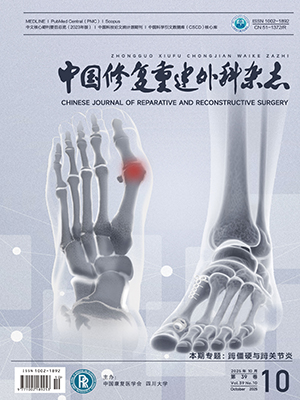Objective To explore the safety and effectiveness of the “talus home technique (THT) ” in the surgery of pronation open ankle fractures (POAF). Methods A retrospective analysis was conducted on 14 patients with POAF admitted between January 2023 and December 2023 who met the selection criteria. There were 7 males and 7 females; age ranged from 26 to 58 years, with a median age of 53 years. Injury causes included 9 cases of traffic accident injury, 3 cases of fall from hight injury, and 2 cases of crush injury. There were 5 cases of type Ⅱ, 6 cases of type ⅢA, and 3 cases of type ⅢB according to Gustilo classification; and 6 cases of pronation-abduction grade Ⅲ and 8 cases of pronation-external rotation grade Ⅳ according to Lauge-Hansen classification. Emergency first-stage debridement of the ankle joint was performed, followed by second-stage open reduction and internal fixation surgery. The THT was used through a limited incision on the lateral malleolus to restore the height of the lateral malleolus, rotational alignment, and anatomical relationship of the distal tibiofibular syndesmosis (DTFS). Wound healing was observed postoperatively. At 4 months postoperatively, weight-bearing anteroposterior, lateral, and mortise view X-ray films and CT scans of both ankles were reviewed to measure the medial clear space (MCS), tibiofibular clear space (TFCS), distal fibular tip to lateral process of talus (DFTL), and anterior/posterior syndesmosis distances of DTFS, and the quality of reduction of ankle fractures was evaluated. Ankle joint function was assessed using the American Orthopedic Foot and Ankle Society (AOFAS) ankle-hindfoot score, and active dorsiflexion/plantar flexion range of motion were recorded at last follow-up. Results After second-stage internal fixation, 8 patients achieved wound healing by first intention, 1 case had skin edge necrosis, 2 cases had local skin necrosis, 1 case had extensive medial soft tissue defect, and 2 cases developed medial wound infection with sinus formation. All 14 patients were followed up 13-24 months (mean, 16.8 months). Postoperative X-ray films showed 1 case of delayed union of the lateral malleolus, which healed after bone grafting at 12 months; the remaining 13 cases achieved clinical union at 12-32 weeks (mean, 21.5 weeks). At 4 months postoperatively, X-ray films and CT examination showed no significant differences in MCS, TFCS, DFTL, and anterior/posterior syndesmosis distances of DTFS between the healthy and affected sides (P>0.05), with no poor DTFS reduction. AOFAS ankle-hindfoot score ranged from 80 to 95, with an average of 87.7; ankle range of motion ranged from 10° to 25° (mean, 19.6°) in dorsiflexion and from 32° to 50° (mean, 41.2°) in plantar flexion. Conclusion THT is safe and effective in POAF surgery. It can restore lateral malleolar height and rotational alignment, enhance DTFS reduction quality, and obtain satisfactory short-term functional recovery of the ankle.
Citation:
SUN Zhenhui, HU Jinxi, ZHANG Yanci, LIU Dehang, LEI Jianyi, GUO Jianbo. Clinical application of “talus home technique” in pronation open ankle fractures. Chinese Journal of Reparative and Reconstructive Surgery, 2025, 39(5): 542-549. doi: 10.7507/1002-1892.202502025
Copy
Copyright © the editorial department of Chinese Journal of Reparative and Reconstructive Surgery of West China Medical Publisher. All rights reserved




